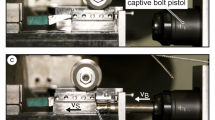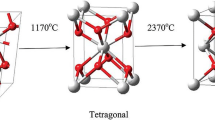Abstract
In this study, single-point grinding experiments were performed on alumina and zirconia ceramics to investigate the grinding processes under two-dimensional compressive prestress (TCP). Grinding forces and grooves were measured under different values of TCP to evaluate the grinding defects. The material removal rate and actual grinding depth were exploited to investigate the grinding-induced damage and material removal mechanisms. The results demonstrate that the grinding forces show an increasing tendency with the increasing values of TCP, while the cracks and chipping along the grinding groove edges of both alumina and zirconia ceramics can be reduced. In addition, the material removal rates of both alumina and zirconia ceramics show the same change tendency with the grinding-induced damage for decreasing the actual grinding depth under different values of TCP.














Similar content being viewed by others
Abbreviations
- TCP:
-
two-dimensional compressive prestress
References
Agarwal, S., & Rao, P. V. (2008). Experimental investigation of surface/subsurface damage formation and material removal mechanisms in SiC grinding. International Journal of Machine Tools and Manufacture,48, 698–710. https://doi.org/10.1016/j.ijmachtools.2007.10.013.
Xie, J., Li, Q., Sun, J. X., & Li, Y. H. (2015). Study on ductile-mode mirror grinding of SiC ceramic freeform surface using an elliptical torus-shaped diamond wheel. Journal of Materials Processing Technology,222, 422–433. https://doi.org/10.1016/j.jmatprotec.2015.03.027.
Malkin, S., & Ritter, J. E. (1989). Grinding mechanisms and strength degradation for ceramics. Journal of Engineering for Industry,111, 167–174.
Zhang, B., Zheng, X. L., Tokura, H., & Yoshikawa, M. (2003). Grinding induced damage in ceramics. Journal of Materials Processing Technology,132, 353–364. https://doi.org/10.1016/S0924-0136(02)00952-4.
Lee, S. J., Do, Kim J., & Suh, J. (2014). Microstructural variations and machining characteristics of silicon nitride ceramics from increasing the temperature in laser assisted machining. International Journal of Precision Engineering and Manufacturing,15, 1269–1274. https://doi.org/10.1007/s12541-014-0466-y.
Zhang, Q., Fu, Y., Su, H., et al. (2018). Surface damage mechanism of monocrystalline silicon during single point diamond grinding. Wear,396–397, 48–55. https://doi.org/10.1016/j.wear.2017.11.008.
Bifano, G. T. (1991). Ductile-regime grinding: A new technology for machining brittle materials. Journal of Engineering for Industry,113, 184.
Dai, J., Su, H., Yu, T., et al. (2018). Experimental investigation on materials removal mechanism during grinding silicon carbide ceramics with single diamond grain. Precision Engineering,51, 271–279. https://doi.org/10.1016/j.precisioneng.2017.08.019.
Kttagawa, T., & Maekawa, K. (1990). Plasma hot machining for new engineering materials. Wear,139, 251–267. https://doi.org/10.1016/0043-1648(90)90049-G.
Huang, H., & Liu, Y. C. (2003). Experimental investigations of machining characteristics and removal mechanisms of advanced ceramics in high speed deep grinding. International Journal of Machine Tools and Manufacture,43, 811–823. https://doi.org/10.1016/S0890-6955(03)00050-6.
Ramesh, K., Yeo, S. H., Gowri, S., & Zhou, L. (2001). Experimental evaluation of super high-speed grinding of advanced ceramics. The International Journal of Advanced Manufacturing Technology,17, 87–92. https://doi.org/10.1007/s001700170196.
Heard, H. C., & Cline, C. F. (1980). Mechanical behaviour of polycrystalline BeO, Al2O3 and AlN at high pressure. Journal of Materials Science,15, 1889–1897. https://doi.org/10.1007/BF00550614.
Huang, H., Damjanac, B., & Detournay, E. (1997). Numerical modeling of normal wedge indentation in rocks with lateral confinement. International Journal of Rock Mechanics and Mining Sciences,34, 613. https://doi.org/10.1016/S1365-1609(97)00169-X.
Crossland, B. (1958). The plastic flow and fracture of a 《Brittle》 material (gley cast iron) with particular reference to the effect of fluid pressure. Proceedings of the Institution of Mechanical Engineers,172, 805–820.
Yoshino, M., Aoki, T., Sugishima, T., & Shirakashi, T. (1999). Scratching test on hard-brittle materials under high hydrostatic pressure. Seimitsu Kogaku Kaishi/Japan Society of Precision Engineering,65, 1481–1485. https://doi.org/10.1115/1.1347035.
Yoshino, M., Aoki, T., Shirakashi, T., & Komanduri, R. (2001). Some experiments on the scratching of silicon: In situ scratching inside an SEM and scratching under high external hydrostatic pressures. International Journal of Mechanical Sciences,43, 335–347. https://doi.org/10.1016/S0020-7403(00)00019-9.
Tan, Y., Jiang, S., Yang, D., & Sheng, Y. (2011). Scratching of Al2O3under pre-stressing. Journal of Materials Processing Technology,211, 1217–1223. https://doi.org/10.1016/j.jmatprotec.2011.02.005.
Zhang, G., Zeng, Y., Zhang, W., et al. (2016). Monitoring for damage in two-dimensional pre-stress scratching of SiC ceramics. International Journal of Precision Engineering and Manufacturing,17, 1425–1432. https://doi.org/10.1007/s12541-016-0168-8.
Zhang, B., Wang, J., Yang, F., & Zhu, Z. (1999). The effect of machine stiffness on grinding of silicon nitride. International Journal of Machine Tools and Manufacture,39, 1263–1283.
Lawn, B. R., & Swain, M. V. (1975). Microfracture beneath point indentations in brittle solids. Journal of Materials Science,10, 113–122. https://doi.org/10.1007/BF00541038.
Jiang, S., Tan, Y., Zhang, G., et al. (2013). Mechanics model for ceramic materials machining under compressive pre-stress. Journal of the Chinese Ceramic Society,6, 738–744.
Conway, J. C., & Kirchner, H. P. (1980). The mechanics of crack initiation and propagation beneath a moving sharp indentor. Journal of Materials Science,15, 2879–2883. https://doi.org/10.1007/BF00550558.
Zhou, Yichun. (2008). Solid mechanics in materials. China: Beijing.
Acknowledgements
The work was supported by the National Natural Science Foundation of China (NSFC) (Project Nos. 51775469, 51704256, 91860133) and Hunan Province Natural Science Foundation (Project No. 2017JJ4051).
Author information
Authors and Affiliations
Corresponding author
Additional information
Publisher's Note
Springer Nature remains neutral with regard to jurisdictional claims in published maps and institutional affiliations.
Rights and permissions
About this article
Cite this article
Zhang, G., Wang, Z., Chen, W. et al. Single-Point Grinding of Alumina and Zirconia Ceramics Under Two-Dimensional Compressive Prestress. Int. J. Precis. Eng. Manuf. 21, 1–9 (2020). https://doi.org/10.1007/s12541-019-00232-8
Received:
Revised:
Accepted:
Published:
Issue Date:
DOI: https://doi.org/10.1007/s12541-019-00232-8




